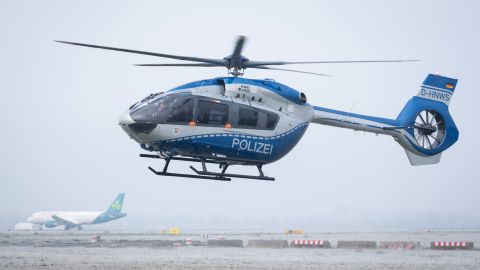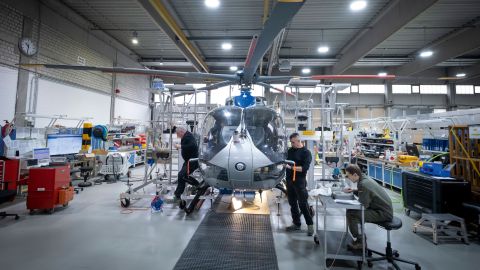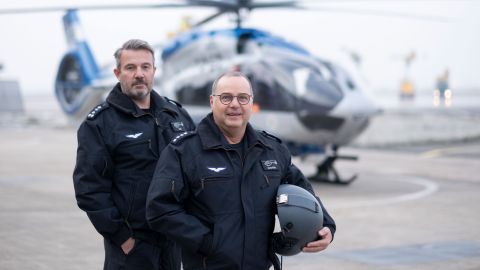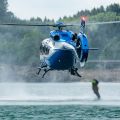The police flight squadron in NRW often faces major challenges. This time, however, it takes a particularly long breath. "But we can do teamwork," beams Thorsten Voss, the Technical Director, in Hangar 10 at Düsseldorf Airport. The conversion of the Airbus H 145 helicopter from a four-blade to a five-blade rotor system has taken a lot of effort and is now nearing completion.
According to the First Chief Superintendent of Police, the upgrade will soon be completed. His team is converting three of the six helicopters, while three others are being modernized by the industry. "We needed two years' lead time alone to clarify the organizational details with the manufacturer and the authorities." It was clear that the usual maintenance work and missions could not be allowed to suffer as a result.
"We are pretty much at our limit," says the Bochum native. In recent years, new tasks such as fighting forest fires have been added. "It's not easy to find a slot for such an extensive upgrade." The improvements will help to meet the requirements.
The H 145 is currently the "most universal police helicopter" on the world market. But the helicopter had a vibration problem. "That used to be quite a burden for every crew and it was also damaging for the sensitive technology." Voß is particularly pleased that the machine with five rotor blades hardly vibrates any more. The anti-vibration system, which weighed a good 20 kilos and was installed as a makeshift solution, is now superfluous and will be removed.
The additional rotor blade increases the payload by 100 kilos, resulting in a total gain of 120 kilos. "In firefighting, that's a whole ton for ten rounds with extinguishing water," says the 51-year-old officer. That brings a lot.
Thorsten Voß knows what he's talking about. He trained as a pilot from 2001 to 2002. He came out on top in a multi-stage selection process. Before that, he was a police officer at Wuppertal police headquarters. "I always liked working on motorcycles or cars, but I never dreamed of flying as a child," he says, putting a damper on the usual romanticism surrounding professional pilots.
His whole team is challenged at the moment. All maintenance work is being carried out in the state capital on the freight route. Dortmund is the squadron's second location after Düsseldorf. There are around 90 employees in total, including more than 40 pilots. 15 technicians are currently directly involved in the conversion work.
The new bearingless main rotor design of the H 145 not only increases flight comfort. Maintenance should also be easier. The conversion from four to five rotors was started in September last year. The operation far exceeds the usual retrofitting process, which involves modifying the software, installing a heater or optimizing the lighting.
By spring, the third helicopter at Düsseldorf Airport should also have five rotors. Industry is also almost finished with its workload and will deliver the last refurbished aircraft in the summer.
In the wide hall near the ICE long-distance train station at the airport taxiway, the technicians are used to preparing for acute crises. For example, when thermal imaging cameras or heavy winches need to be removed quickly to make the aircraft as light as possible for forest firefighting. After fighting a major fire, the engines have to be thoroughly cleaned because soot particles have accumulated. Daily wear and tear must also be checked to guarantee safety.
The technicians have a great responsibility. They have a duty to document every work step in order to ensure seamless controlling. It's always about protecting the helicopter crew. The pilot, co-pilot and operator must be safe if they are to rescue people from great danger or pursue suspects from the air. And the equipment has to work.
"That's why I find the work here particularly satisfying," says avionics tester Jörg Menzel. He has worked in companies in the aviation industry for a long time. He moved to the aviation squadron a good two years ago. The 61-year-old says that the atmosphere at the police force is very collegial and pleasant. He also likes the working conditions. The electronics specialist had never known a heated hangar in his previous jobs.
Menzel and his colleagues had to thoroughly disassemble the H145 to ensure that everything was compatible. It's not just about the rotors. "We laid cable harnesses and connections, installed an electronic hydraulic pump and moved the ELT emergency transmitter from the front to the rear," he reports. "I enjoy it when something is going on."
Police Chief Inspector Stephan Augustin is just taking off on a test flight with his five-bladed machine. "We ended up making a whole range of changes. A technician is always present during such a test," says the pilot. "He checks whether all the prescribed parameters are met."
A lot has been achieved in the past few months. But Thorsten Voß is looking ahead: "We are working closely with the fire department to prepare for possible forest fires with the new helicopter." He says that the air squadron does a brilliant job in disasters like the one on the Ahr and elsewhere. "And we want to continue to be just as successful."




